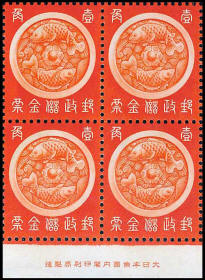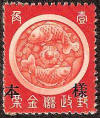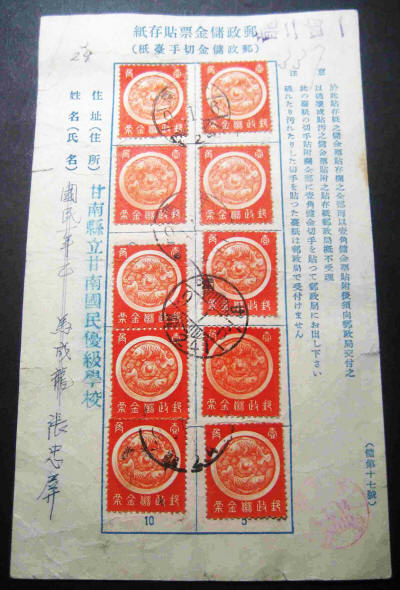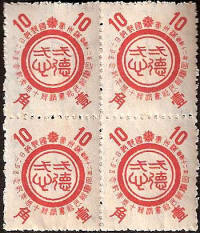 |
||||||||
|
|
Postal Saving Stamp (First Issue) Issued 1st March 1941 These stamps were used as Post Office Saving Stamps, they could not be used for postal purposes (in Japan a Japanese savings stamp could be used for saving or for post). Postal saving is still very popular in rural areas where the population do not have easy access to a bank, and also for encouraging children to save. The characters read, top "壹角: One chiao (10f)", bottom "郵政儲金票 - Postal Savings Stamp". The stamp is photogravure printed on un-watermarked paper in sheets of 100, the reverse has an even coating of whitish gum. The 12 character imprint reads "Manufactured by Japanese Imperial Printing Bureau" designer unknown. See a full sheet scan here. Design 19.3mm x 22mm Perf 13 x 13. The design represents two carp in a bowl with a pearl at the centre - a symbol for good luck. The Chinese word for fish is "Yu" and the Chinese word for abundance is "Yu" so a play on words links the two; the carp is also known as the "messenger" fish, which ties in nicely with the Post Office.
|
|||||||
|
|
||||||||
|
1 Chiao (10fen) |
||||||||
| 樣本: Sample | ||||||||
|
The above stamp overprinted 樣本 meaning "sample" has been taken from a savings book. The sample stamps were added to show people the stamps they were supposed to use. The savings forms were provided free by Post Offices and had spaces for 10 savings stamps. When a customer had collected 10 stamps, the book was taken to a Post Office and 100f (1 Yuan) was added to the customers savings account. Once a savings form had been cashed-in the rules stated that it must be destroyed. Above is a completed savings form from 甘南 Kan-nan or Gannan savings office number 241 with a cancellation date of 6th January 1942 - a rare survivor. First or second issue stamps overprinted with the word SPECIMEN in English are fakes. |
||||||||
|
|
||||||||
|
Postal Saving Stamp (Second Issue) Late 1945 This new issue quite probably never went into use but why the design change? Here is a theory, the design represents the reverse colours of the first issue and these echo the final postage stamp for Manchukuo based upon the 10th Anniversary of the Emperor's Edict (see below). Following the revision the two stamps look in many ways similar. It is possible that it had been planned to make the two stamps interchangeable for use in savings booklets - both stamps had the same value. Not all Postal outlets handled saving stamps but postage stamps could be obtained from all Postal Agencies. The final postage stamp for Manchukuo and similar to the last saving stamp below. This is one of the few stamps issued in Manchukuo without gum. In this instance litho printed on white watermarked paper (see below). Watermarking a security feature missing from the earlier version which may have counterfeited on an unacceptable scale. Due to the similarity of the design the printers are likely to be as above, however as these sheets were issued without an imprint it is difficult to be sure. Designers unknown. Plate numbers have appear in the right hand sheet margin.
Design 19.3mm x 22mm. Perf 13 x 13.
|
||||||||
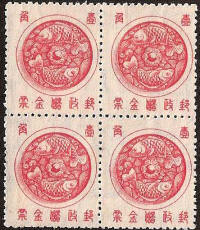 |
||||||||
| 1 Chiao (10fen) | ||||||||
|
Postal Saving was obviously very popular in Manchukuo. When the war ended and the state reverted to China there must have been millions of these stamps around which would then have been worthless. They are the most common Chinese "Cinderella" and seldom appear in mainstream catalogues.
|
||||||||
|
|
||||||||
| Manchukuoan Post Office Savings Certificate | ||||||||
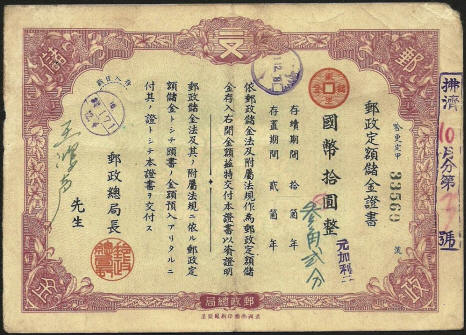 |
||||||||
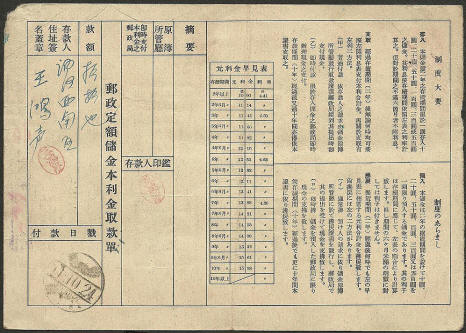 |
||||||||
|
This is a savings certificate issued by
the Post Office of Manchukuo, (note the Post Office logo at the
top). In this instance a sum of money was deposited on 4th December
1943 and the certificate was cashed on 24th October 1944. The certificate is printed on thick paper with a watermark of six large characters MANZHOU DIGUO ZHENGFU (满洲帝国政府) "Manchurian Empire Government". The imprint at the base of the certificate reads; MANZHOU DIGUO YINSHUA CHANG ZHIZAO (满洲帝国印刷厂制造) "Manchurian Empire Printing Factory Manufactured" My thanks to Neil Kaplan for providing this image and the interpretations shown above. |
||||||||
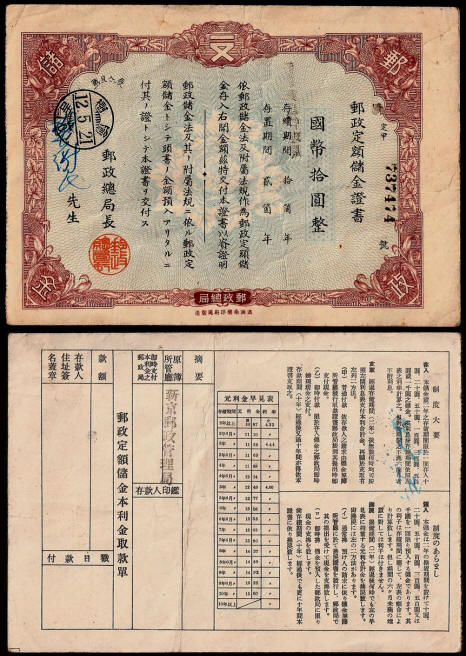 |
||||||||
| This is a similar example issued in 榆樹 Yushu on 21st May 1945 shortly before the end of the war, so it may not have been a good investment. | ||||||||
|
|
||||||||
| To find out more about Savings and Investments in Manchukuo click here | ||||||||

